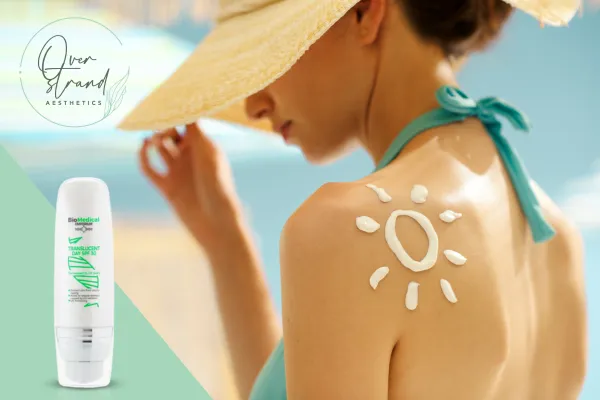
Blog
Blog

The Secrets of Sun Protection: Know Your SPF
In the pursuit of healthy and radiant skin, understanding the importance of sun protection is vital. Overstrand Aesthetics is dedicated to providing you with the knowledge and tools necessary to safeguard your skin from the harmful effects of UV rays. In this blog post, we delve into the world of SPF, exploring its different types, the significance of UVA and UVB rays, and essential tips for optimal sun protection.
Know Your SPF
Sun protection is not merely an occasional ritual; it should be an integral part of your daily skincare routine. Applying sunscreen in the morning and reapplying every 2 to 3 hours when outdoors is crucial. The sun emits both UVA and UVB rays, each with distinct effects on the skin.
UVA rays penetrate deep into the skin, causing indirect DNA damage by generating free radicals. These rays are prevalent all year round and contribute to premature ageing, pigmentation, and skin cancer. On the other hand, UVB rays, also known as sunburn rays, directly damage DNA and are associated with an increased risk of skin cancer.
Two Different Kinds of SPF
When it comes to choosing sunscreens, there are two main types: mineral and chemical. Mineral sunscreen contains Titanium dioxide and Zinc oxide, forming a protective barrier on the skin that reflects and absorbs UV rays. This type is ideal for those with acne-prone and sensitive skin, as it is less likely to cause irritation.
Chemical sunscreens are absorbed through the skin and undergo a reaction that provides sun protection. Understanding the UVB and UVA blockers present in sunscreens is crucial for selecting the right product. UVB blockers include Aminobenzoates, Cinnamates, Salicylates, Octocrylene, Ensulizole, and Camphor derivatives. UVA blockers include Benzophenones, Anthranilates, Avobenzones, and Ecamsule.
Choosing the Right Sunscreen
It is essential to choose sunscreens that are well-formulated and tested for safety and efficacy. Look for products that provide protection against both UVA and UVB rays, ensuring comprehensive coverage. Overstrand Aesthetics recommends staying away from sunscreens with harmful ingredients and opting for those that prioritise your skin's health. We stock and recommend trusted Biomedical Emporium’s Translucent Day SPF 30 Spritz.
Best Practices for Sun Protection
Understanding the timing of UV radiation is crucial. UV rays are strongest between 10:00 am and 4:00 pm, making it advisable to avoid prolonged sun exposure during these hours. If being outside is unavoidable, consider additional protection such as UV-protective clothing and a wide-brimmed hat.
Conclusion
Overstrand Aesthetics encourages you to make informed choices about sun protection. By incorporating the right sunscreen into your daily routine and following best practices, you can enjoy the sun responsibly, ensuring that your skin remains healthy and beautiful for years to come. Prioritise your skin's well-being, because when it comes to sun protection, knowledge is the key to a radiant future.

The Secrets of Sun Protection: Know Your SPF
In the pursuit of healthy and radiant skin, understanding the importance of sun protection is vital. Overstrand Aesthetics is dedicated to providing you with the knowledge and tools necessary to safeguard your skin from the harmful effects of UV rays. In this blog post, we delve into the world of SPF, exploring its different types, the significance of UVA and UVB rays, and essential tips for optimal sun protection.
Know Your SPF
Sun protection is not merely an occasional ritual; it should be an integral part of your daily skincare routine. Applying sunscreen in the morning and reapplying every 2 to 3 hours when outdoors is crucial. The sun emits both UVA and UVB rays, each with distinct effects on the skin.
UVA rays penetrate deep into the skin, causing indirect DNA damage by generating free radicals. These rays are prevalent all year round and contribute to premature ageing, pigmentation, and skin cancer. On the other hand, UVB rays, also known as sunburn rays, directly damage DNA and are associated with an increased risk of skin cancer.
Two Different Kinds of SPF
When it comes to choosing sunscreens, there are two main types: mineral and chemical. Mineral sunscreen contains Titanium dioxide and Zinc oxide, forming a protective barrier on the skin that reflects and absorbs UV rays. This type is ideal for those with acne-prone and sensitive skin, as it is less likely to cause irritation.
Chemical sunscreens are absorbed through the skin and undergo a reaction that provides sun protection. Understanding the UVB and UVA blockers present in sunscreens is crucial for selecting the right product. UVB blockers include Aminobenzoates, Cinnamates, Salicylates, Octocrylene, Ensulizole, and Camphor derivatives. UVA blockers include Benzophenones, Anthranilates, Avobenzones, and Ecamsule.
Choosing the Right Sunscreen
It is essential to choose sunscreens that are well-formulated and tested for safety and efficacy. Look for products that provide protection against both UVA and UVB rays, ensuring comprehensive coverage. Overstrand Aesthetics recommends staying away from sunscreens with harmful ingredients and opting for those that prioritise your skin's health. We stock and recommend trusted Biomedical Emporium’s Translucent Day SPF 30 Spritz.
Best Practices for Sun Protection
Understanding the timing of UV radiation is crucial. UV rays are strongest between 10:00 am and 4:00 pm, making it advisable to avoid prolonged sun exposure during these hours. If being outside is unavoidable, consider additional protection such as UV-protective clothing and a wide-brimmed hat.
Conclusion
Overstrand Aesthetics encourages you to make informed choices about sun protection. By incorporating the right sunscreen into your daily routine and following best practices, you can enjoy the sun responsibly, ensuring that your skin remains healthy and beautiful for years to come. Prioritise your skin's well-being, because when it comes to sun protection, knowledge is the key to a radiant future.


Opening Hours
Mon - Fri: 9am - 5pm
Saturday: 8am - 1pm
Sunday: Closed
Find us
5 Dirkie Uys street, Hermanus, 7200


Opening Hours
Mon - Fri: 9am - 5pm
Saturday: 8am - 1pm
Sunday: Closed
Find us
5 Dirkie Uys street, Hermanus, 7200
© Copyright 2025 Overstrand Aesthetics. All rights reserved.

